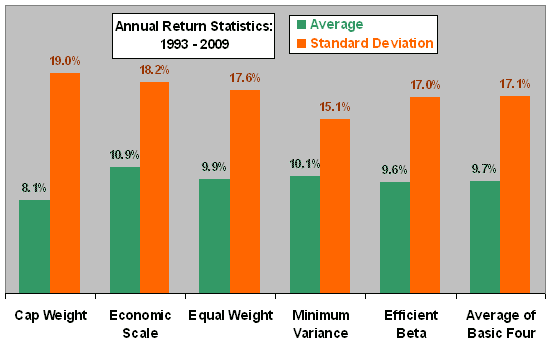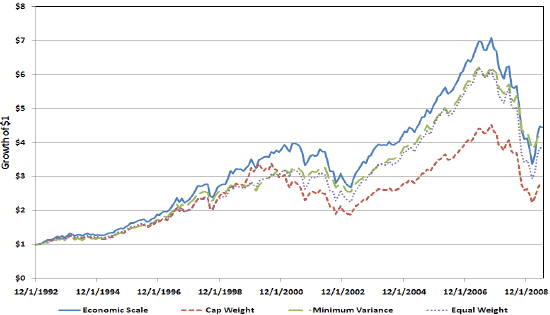Are there alternatives to traditional beta and capitalization weighting strategies for asset allocation that improve investing outcomes? In the October 2009 version of their paper entitled “Beyond Cap-Weight: The Empirical Evidence for a Diversified Beta”, Rob Arnott, Vitali Kalesnik, Paul Moghtader and Craig Scholl explore diversification of beta risk by comparing the merits of four basic major strategies for portfolio weighting from a global perspective: Cap Weight; Equal Weight; Minimum Variance weighting; and, Economic Scale weighting. They also examine two combination strategies: Efficient Beta, an equal weighting of Cap Weight, Economic Scale and Minimum Variance; and, an equal weighting of all four basic strategies. Using dollarized returns and other data necessary for construction of indexes comprised of the 1,000 largest (by market capitalization) companies across 23 developed countries over the period January 1993 through June 2009, they conclude that:
- Each basic alternative beta strategy has merit:
- Cap Weight offers scalability and theoretical purity.
- Equal Weight has the longest live track record of added value.
- Minimum Variance weighting has the highest historical Sharpe ratio and lowest risk.
- Economic Scale weighting has the highest information ratio.
- Based on annual returns over the entire sample period, Economic Scale weighting has the highest average return and Minimum Variance weighting has the lowest volatility (see first chart below).
- Based on cumulative returns, all five basic and combination alternatives outperform Cap Weight.
- The alternative strategies arguably offer “better beta” rather than alpha.
- Empirical results suggest global market inefficiencies that reflect gaps between expected and observed risk, expected return and expected utility, and/or priced risk factors and actual risk factors.
The following chart, constructed from data in the paper, compares the average annual returns and the standard deviations of annual returns for the four basic weighting strategies and the two combination strategies, rebalancing annually and treating partial 2009 as a full year. Results show that Economic Scale weighting has the highest average return and that Minimum Variance weighting has the lowest volatility. All alternatives to Cap Weight increase average return and lower volatility.

The next chart, taken from the paper, compares growth of $1 initial investments in the four basic weighting strategies over the period January 1993 through June 2009. As implied by the prior chart, the three alternative basic weighting strategies outperform Cap Weight. The two combination strategies (not shown) also therefore outperform Cap Weight.

In summary, evidence from a relatively short history of global stock returns indicates that portfolio weighting based on mechanical metrics other than market capitalization may enhance raw and risk-adjusted return.